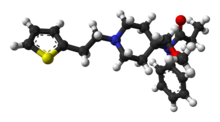
Back سوفينتانيل Arabic سوفنتانیل AZB Sufentanil Czech Swffentanil Welsh Sufentanil German Sufentanilo Spanish Sufentanilo Basque سوفنتانیل Persian Sufentaniili Finnish Sufentanil French
 | |
 | |
| Clinical data | |
|---|---|
| Trade names | Dsuvia, Sufenta, Zalviso |
| Other names | R30730 |
| AHFS/Drugs.com | Monograph |
| License data |
|
| Routes of administration | Intravenous therapy (IV), intramuscular injection (IM), subcutaneous injection (SQ), epidural, intrathecal, sublingual |
| ATC code | |
| Legal status | |
| Legal status |
|
| Pharmacokinetic data | |
| Bioavailability | 53% (sublingual) |
| Elimination half-life | 162 minutes |
| Duration of action | 30 to 60 min[3] |
| Identifiers | |
| |
| CAS Number | |
| PubChem CID | |
| IUPHAR/BPS | |
| DrugBank | |
| ChemSpider | |
| UNII | |
| KEGG | |
| ChEBI | |
| ChEMBL | |
| CompTox Dashboard (EPA) | |
| ECHA InfoCard | 100.168.858 |
| Chemical and physical data | |
| Formula | C22H30N2O2S |
| Molar mass | 386.55 g·mol−1 |
| 3D model (JSmol) | |
| Melting point | 97 °C (207 °F) |
| |
| |
| (verify) | |
Sufentanil, sold under the brand names Dsuvia and Sufenta, is a synthetic opioid analgesic drug approximately 5 to 10 times as potent as its parent drug, fentanyl, and 500 to 1,000 times as potent as morphine. Structurally, sufentanil differs from fentanyl through the addition of a methoxymethyl group on the piperidine ring (which increases potency but is believed to reduce duration of action[4]), and the replacement of the phenyl ring by thiophene. Sufentanil first was synthesized at Janssen Pharmaceutica in 1974.[5]
Sufentanil is marketed for use by specialist centers[clarification needed] under different trade names, such as Sufenta and Sufentil. Sufentanil with and without lidocaine or mepivacaine is available as a transdermal patch similar to Duragesic in Europe under trade names such as Chronogesic. It is available as a sublingual tablet under the trade name Dsuvia.[6]
- ^ "FDA-sourced list of all drugs with black box warnings (Use Download Full Results and View Query links.)". nctr-crs.fda.gov. FDA. Retrieved 22 Oct 2023.
- ^ Anvisa (2023-03-31). "RDC Nº 784 - Listas de Substâncias Entorpecentes, Psicotrópicas, Precursoras e Outras sob Controle Especial" [Collegiate Board Resolution No. 784 - Lists of Narcotic, Psychotropic, Precursor, and Other Substances under Special Control] (in Brazilian Portuguese). Diário Oficial da União (published 2023-04-04). Archived from the original on 2023-08-03. Retrieved 2023-08-16.
- ^ Shaw, Leslie M. (2001). The clinical toxicology laboratory : contemporary practice of poisoning evaluation. Washington, DC: AACC Press. p. 89. ISBN 9781890883539.
- ^ Vucković S, Prostran M, Ivanović M, Dosen-Mićović Lj, Todorović Z, Nesić Z, Stojanović R, Divac N, Miković Z (2009). "Fentanyl analogs: structure-activity-relationship study". Curr Med Chem. 16 (9): 2468–2474. doi:10.2174/092986709788682074. PMID 19601792.
- ^ Niemegeers CJ, Schellekens KH, Van Bever WF, Janssen PA (1976). "Sufentanil, a very potent and extremely safe intravenous morphine-like compound in mice, rats and dogs". Arzneimittel-Forschung. 26 (8): 1551–6. PMID 12772.
- ^ Silverman, Ed (November 2, 2018). "Despite criticism and concerns, FDA approves a new opioid 10 times more powerful than fentanyl". Pharmalot. Retrieved November 2, 2018.
© MMXXIII Rich X Search. We shall prevail. All rights reserved. Rich X Search